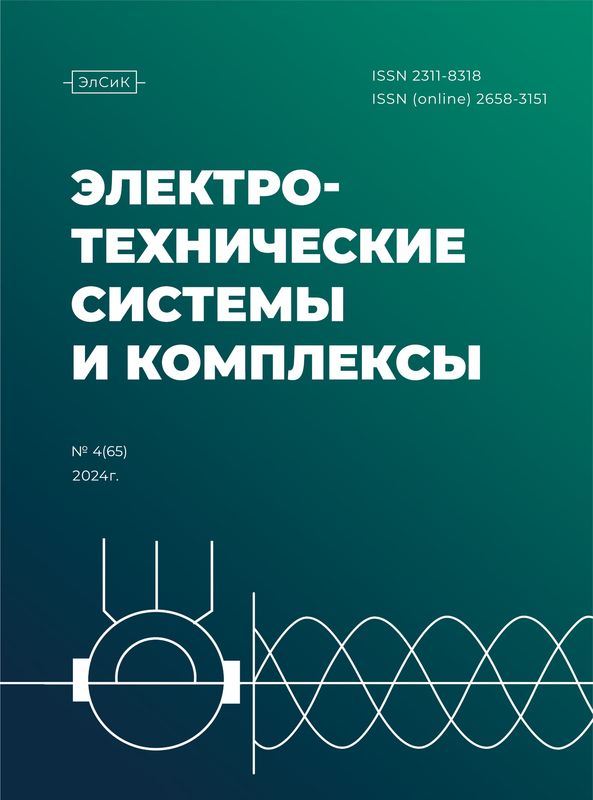Abstract
The active introduction of distributed generation and an increase in the number of grid-tied inverters in power supply systems in recent years, combined with the growth of modern microprocessor technology computing power, opens up opportunities to expand the inverter functionality in terms of filtering higher harmonics to ensure the power system electromagnetic compatibility. The paper considers a control system for a voltage source inverter of the virtual synchronous machine type with an integrated algorithm for active harmonics filtering of nonlinear load current according to the d-q theory. The developed algorithm has been tested using computer simulating in the Matlab/Simulink software package using the Simscape component library. As a part of the developed algorithm effectiveness evaluation, a comparison of the mains voltage and current harmonic composition in a scenario with complete correction absence, when using a classical parallel active filter and when using the developed algorithm with and without electric power generation to the grid was carried out. The positive effect of the developed algorithm on the harmonic composition of the grid voltage and current in a narrow range due to the presence of the inverter output capacitances is noted. The harmonic filtering algorithm uses the currently unused inverter power, so the filtering efficiency is inversely proportional to the useful electrical power generated by the inverter into the grid. Given the relatively high cost of the active filter kit, the proposed method of retrofitting the inverter may become a more preferable alternative due to lower capital costs. To implement the system, in addition to updating the inverter software, it will be necessary to add three measuring channels of the load phase current.
Keywords
active filters, distributed generation, grid-tied inverters, virtual synchronous machine
1. State Standard 32144–2013. Electric energy. Electromagnetic compatibility of technical equipment. Power quality limits in the public power supply systems. Moscow, STANDARTINFORM Publ., 2014. 19 p. (In Russian)
2. Voropay N.I. Prospects and Problems of Electric Power System Transformations. Еlectrichestvo [Elektrichestvo], 2020, no. 7, pp. 12–21. (In Russian) doi: https://doi.org/10.24160/0013-5380-2020-7-12-21
3. Yamamoto F., Kitamura A., Fujita N., Nakanishi Y., Naga-sawa M. A study on optimal locations and sizes of active fil-ters as an additional function of distributed generation sys-tems. IEEE International Conference on Systems, Man, and Cybernetics. IEEE, 1999, vol. 6, pp. 515-520. doi: 10.1109/ ICSMC.1999.816605
4. Bai H., Shang S. A research of combined multifunctional three phase grid-connected inverter/active power filter for PV system. The 2nd International Symposium on Power Electronics for Distributed Generation Systems. IEEE, 2010. Pp. 224-228. doi: 10.1109/PEDG.2010.5545852
5. Belenguer E., Beltran H., Aparicio N. Distributed generation power inverters as shunt active power filters for losses min-imization in the distribution network. European Conference on Power Electronics and Applications. IEEE, 2007. Pp. 1-10. doi: 10.1109/EPE.2007.4417552
6. Li S., Li Y., Sun J., Jin Q., Li X. A novel control algorithm for inverter-based distributed generation in unbalanced three-phase power systems. International Conference on Sustaina-ble Power Generation and Supply. IEEE, 2009, Pp. 1-6. doi:10.1109/SUPERGEN.2009.5348276
7. Wen B., Boroyevich D., Burgos R., Mattavelli P., Shen Z. Analysis of D-Q Small-Signal Impedance of Grid-Tied In-verters. IEEE Transactions on Power Electronics. 2016, Vol. 31, no. 1, pp. 675-687. doi: 10.1109/TPEL.2015.2398192
8. Demirkov B., Zarkov Z. Study of Physical Model of WECS with Synchronous Generator and Back-to-back Converter. 16th Conference on Electrical Machines, Drives and Power Systems (ELMA). IEEE, 2019. Pp. 1-6. doi: 10.1109/ELMA. 2019.8771656
9. Tielens P., Van Hertem D. The relevance of inertia in power systems, Renewable and Sustainable Energy Reviews. Re-newable and Sustainable Energy Reviews. 2016, vol. 55, pp. 999-1009. doi: 10.1016/j.rser.2015.11.016
10. Christensen P., Andersen G. K., Seidel M. High Penetration of Power Electronic Interfaced Power Sources and the Poten-tial Contribution of Grid Forming Converters. Available at: https://strathprints.strath.ac.uk/72581/1/ENTSO_E_2020_High_Penetration_of_Power_Electronic_Interfaced_Power_Sources.pdf (accessed 18 August 2025)
11. Barać B., Krpan M., Capuder T., Kuzle I. Modeling and Initialization of a Virtual Synchronous Machine for Power System Fundamental Frequency Simulations. IEEE Access. 2021, vol. 9, pp. 160116-160134. doi: 10.1109/ACCESS. 2021.3130375
12. Akagi H., Watanabe E.H., AredesM.Instantaneous power theory and applications to power conditioning. Wiley: IEEEPress, 2007. 379 p. Available at: https://trinhquocnam.wordpress.com/wp-content/uploads/ 2013/10/ebooksclub-org__instantaneous_power_theory_ and_applications_to_power_conditioning__ieee_press_series_on_power_engineering_.pdf (accessed 18 August 2025)
13. Lee S., Kim H., Sul S., Blaabjerg F. A novel control algo-rithm for static series compensators by use of PQR instanta-neous power theory. IEEE Transactions on Power Electron-ics. 2004, vol. 19, no. 3. pp. 814-827. doi: 10.1109/TPEL. 2004.826499
14. Soares V., Verdelho P., Marques G.D. Active power filter control circuit based on the instantaneous active and reactive current id-iq method. The 28 annual IEEE power electronics specialists conference. IEEE Press, 1997, vol. 2, pp. 1096-1101. doi: 10.1109/PESC.1997.616882
15. Peng F. Z., Ott G. W. Jr., Adams D. J. Harmonic and reactive power compensation based on the generalized instantaneous reactive power theory for three-phase four-wire systems. IEEE Transactions on Power Electronics. 1998, vol. 13, no 6, pp. 1174-1181.doi: 10.1109/63.728344
16. Fryze S. Active, reactive and apparent power in electrical circuits with a non-sinusoidal course of current and voltage. Elektrotechnische Zeitschrift [Electrotechnical Journal], 1932, vol. 53, no 25, pp. 596–599. (In German)
17. Petrov A.A. Metody i sredstva povysheniya kachestva el-ektroenergii v sisteme metropolitena. Kand. Diss. [Methods and means of improving the quality of electricity in the subway system Kand. Diss.]. Novosibirsk, 2019. 162 p. (In Russian)
18. Duesterhoeft W. C., Schulz M. W., Clarke E. Determination of instantaneous currents and voltages by means of alpha, beta, and zero components. Transactions of the American In-stitute of Electrical Engineers. 1951, vol. 70, no. 2, pp. 1248-1255. doi: 10.1109/T-AIEE.1951.5060554
19. Pustokhin P.Yu., Zyuzev A.M., Kryukov O.V. Improvement of network inverters control system in distributed power supply networks at gas compressor stations. Izvestiya Tomskogo politekhnicheskogo universiteta. Inzhiniring georesursov. [Bulletin of the Tomsk Polytechnic University. Geo Assets Engineering], 2025, vol. 336(6), pp. 46-58. (In Russian) doi:10.18799/24131830/2025/6/4336
20. Shrejner R.T. Sistemy podchinennogo regulirovaniya el-ektroprivodov: uchebnoe posobie dlya vuzov. Ch. 1. Elektro-privody postoyannogo toka s podchinennym re-gulirovaniem koordinat [Systems of electric drives subordinate regulation: a textbook for universities. Part 1. DC electric drives with subordinate coordinate regulation]. Moscow, UGPPU Publ., 1997. 277 p. (In Russian)
21. Pustokhin P., Zyuzev A. The Use of Power Decoupling Method and Sliding Mode Current Controllers for Virtual Synchronous Machine. International Ural Conference on Electrical Power Engineering (UralCon). IEEE, 2024. Pp. 807-811. doi: 10.1109/UralCon62137.2024.10718934
22. Smith S. Cifrovaya obrabotka signalov: prakticheskoe rukovodstvo dlya inzhenerov i nauchnyh rabotnikov [Digital Signal Processing. A Practical Guide for Engineers and Sci-entists]. Moscow, DMKPress Publ., 2018. 720 p. (In Rus-sian) ISBN 978-5-97060-635-3.
Pustokhin P.Yu., Zyuzev A.M., Kostylev A.V. Ensuring Electromagnetic Compatibility in Power Supply Networks Equipped with Distributed Generation Sources with Grid-Tied Inverters. Elektrotekhnicheskie sistemy i kompleksy [Electrotechnical Systems and Complexes], 2025, no. 3(68), pp. 42-48. (In Russian). https://doi.org/10.18503/2311-8318-2025-3(68)-42-48










